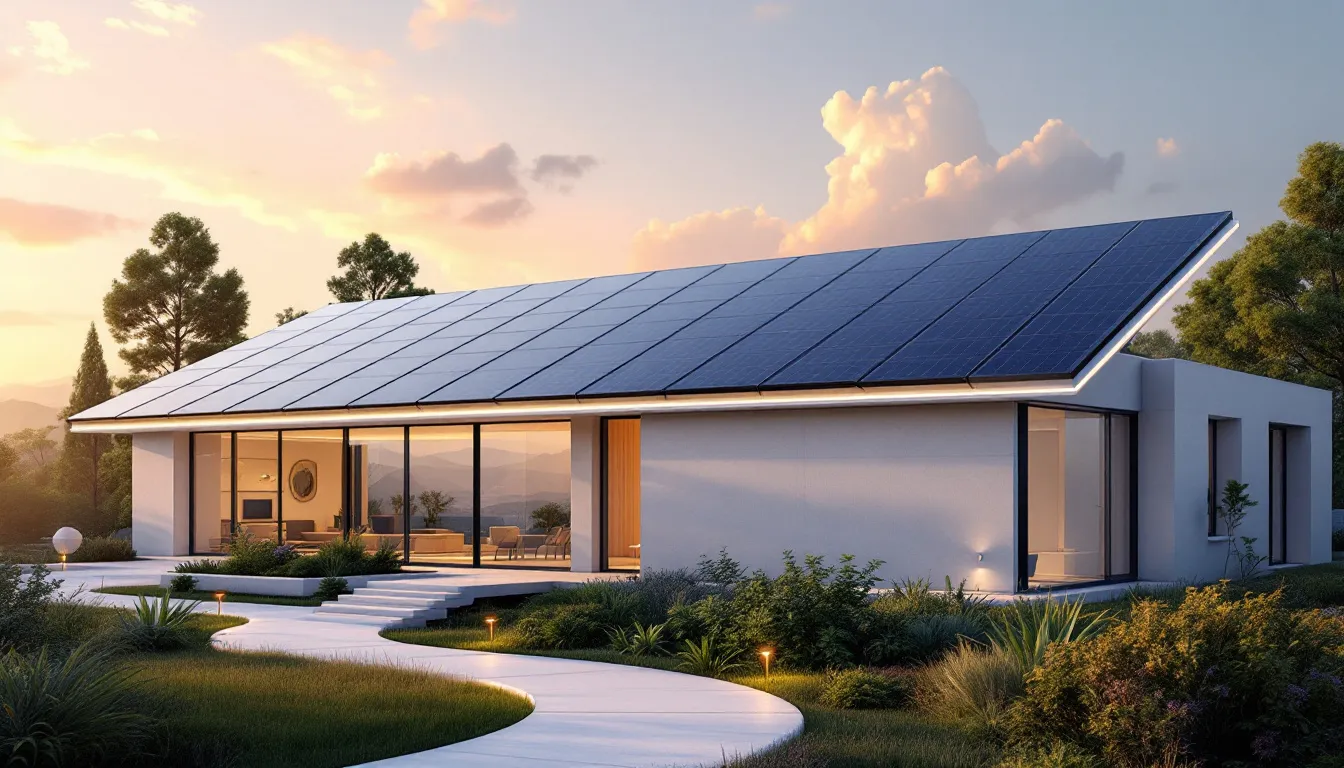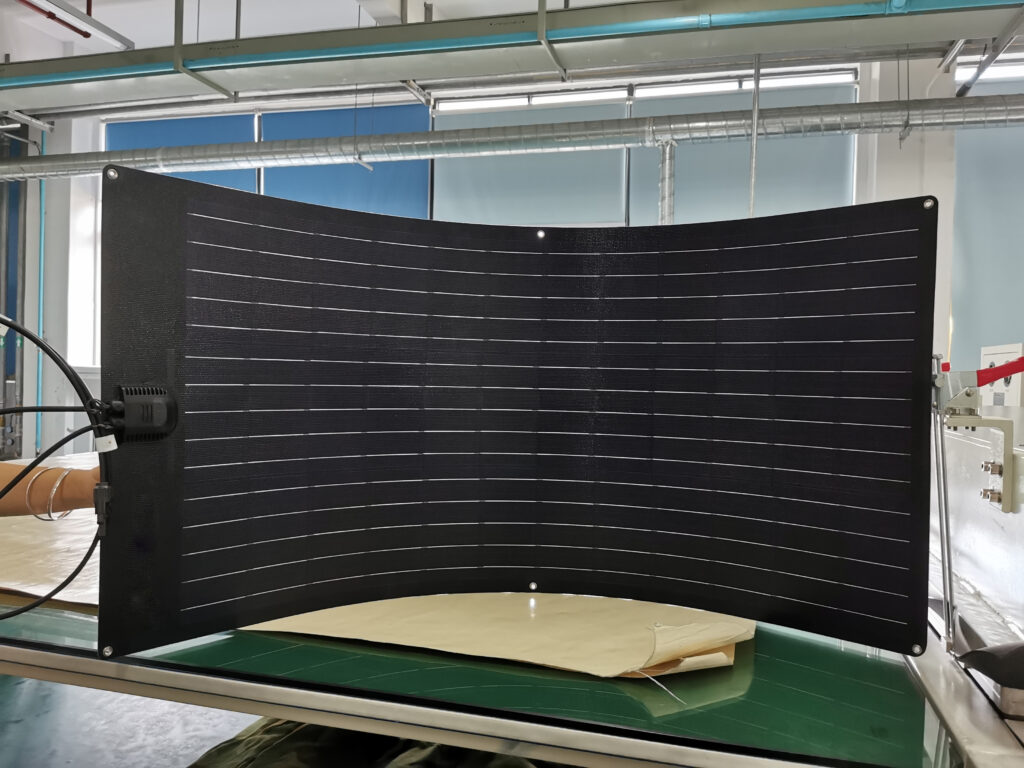Interested in a Solar Array for Home? This guide covers the advantages, types of panels, costs, incentives, and installation options, empowering you to make an informed decision about solar energy.
Key Takeaways
- Installing a solar array provides long-term savings on electricity bills, making the upfront costs more manageable through available financial incentives and rebates.
- Choosing the right type of solar panel—monocrystalline for efficiency or polycrystalline for cost-effectiveness—is crucial based on home conditions and roof space.
- Energy storage solutions enhance the benefits of solar arrays by allowing homeowners to store excess energy, increasing energy independence and reliability during outages.
Understanding Solar Arrays

A solar array consists of multiple solar panels connected in a circuit to effectively capture sunlight and generate electricity produced. These panels, along with inverters and other necessary equipment, form a complete solar power system. When sunlight hits the panels, they produce Direct Current (DC) electricity, which must be converted to Alternating Current (AC) for home use via solar inverters. Understanding how solar panels work is essential for maximizing their efficiency.
Powering an average home usually requires 13 to 21 home solar panels, which varies based on geographic location and daily sunlight hours. Knowing how much power these essentials allow homeowners to better appreciate their solar energy system’s efficiency and capacity.
Types of Solar Panels for Home Use
When it comes to choosing solar panels for home use, there are two main types: monocrystalline and polycrystalline. Monocrystalline panels are known for their high efficiency, typically ranging from 17% to 22%, making them ideal for homes with limited roof space. On the other hand, polycrystalline panels generally have lower efficiency ratings between 15% to 17%, but they are more cost-effective.
Additionally, half-cut solar cells improve panel efficiency by minimizing resistive loss and performing better in shaded conditions. Homeowners with limited roof space may find higher efficiency panels advantageous, as they produce the same output as larger, less efficient panels.
Key Considerations When Choosing a Solar Array
Consider several factors like the age, size, and slope of your roof, potential shade from nearby trees, and overall sunlight availability before installing solar panels, as these can vary depending on the specific conditions of your property.
Additionally, exploring available incentives and rebates, as well as understanding post-installation requirements, will help make an informed decision.
Efficiency Ratings
Efficiency ratings are critical when selecting solar panels, as they determine the energy output relative to the physical size of the panels. Monocrystalline panels, with efficiency ratings between 17% to 22%, are ideal for homes with limited roof space due to their higher energy output.
Polycrystalline panels, with efficiency ratings between 15% to 17%, are a more budget-friendly option but require more space to generate the same amount of electricity. Thin-film solar panels, although lightweight and flexible, have the lowest efficiency ratings of around 10% to 13%, making them significantly lower in suitability for residential use.
These efficiency ratings assist homeowners in selecting the appropriate panels based on their specific needs and roof space constraints.
Cost Analysis
The cost of installing solar panels is a significant consideration for many homeowners. The average price range for solar panels typically falls between $300 to $600 per panel. In 2025, the average solar panels cost of installing a home solar system is projected to be $29,360. While the initial investment may seem high, the long-term savings on electricity bills and the potential for financial benefits from net metering can make solar panels worth it.
Financing options such as loans and leases can help spread out the cost upfront, but paying cash is often the most cost-effective option. Additionally, solar cost calculators available in many states can help homeowners evaluate their savings potential. Comparing quotes and calculating cost per watt based on system capacity can also help determine the most cost-effective solar loan option.
Hybrid solar systems, while requiring a higher initial investment, can offer greater efficiency and long-term savings. Ground-mounted panels may incur higher costs due to the need for additional foundations and permits. Available financial incentives and rebates can notably shorten the payback period for solar panels.
Warranty and Longevity
Warranty terms are vital as they safeguard your investment in solar technology throughout its operational life. The typical duration of product warranties for solar panels is between 10 to 12 years, with a 10% to 20% loss in output expected over a 25-year period.
Installation Options for Solar Arrays
Solar arrays can be installed in various locations, including rooftops, ground mounts, and structures like solar canopies. Each of these options has its own set of benefits and considerations, which we’ll explore in the following subsections.
Roof-Mounted Systems
Roof-mounted solar kits save space and generate renewable energy. They are an efficient solution for homes with limited roof space or less-than-ideal roof conditions. However, rooftop conditions such as age, slope, and shade significantly impact the effectiveness of the solar array.
Installing solar panels on the roof can optimize existing space and integrate seamlessly with the home’s structure. Assessing the roof’s condition ensures it can support the panels and optimize energy production.
Ground-Mounted Systems
Ground-mounted solar systems allow for optimal sunlight exposure since they can be adjusted for maximum efficiency. These systems are typically easier to maintain compared to roof-mounted installations due to their accessibility. Ground-mounted systems are not constrained by roof size, enabling larger solar installations if space permits.
Ground-mounted systems are an excellent choice for properties with ample land. They provide flexibility in positioning and can be adjusted to capture the most sunlight throughout the day.
Hybrid Systems
Hybrid systems combine both roof-mounted and ground-mounted arrays, providing flexibility in energy production. These systems can adapt to varying space and sunlight conditions, maximizing solar energy generation.
Solar Energy Storage Solutions

Energy storage systems like batteries play a crucial role in maximizing the use of solar energy and ensuring power availability during grid failures. They allow homeowners to generate and store their own electricity, increasing independence and optimizing the use of renewable energy, providing them with more energy.
Battery Storage Options
The Tesla Powerwall is one of the most popular home battery systems, designed to store energy from solar panels or the utility grid. It not only stores energy but also allows for energy management in a home, enhancing the overall efficiency of the solar energy system.
Alternatives to the Tesla Powerwall include offerings from companies like SolarEdge and Enphase, providing various choices for homeowners. These alternatives may offer unique features, such as integrated inverter technology or modular design, catering to different homeowner needs.
Benefits of Energy Storage
Energy storage solutions allow homeowners to store excess solar energy generated during peak sunlight hours for use during periods of low production, promoting greater energy independence. By optimizing energy usage and minimizing reliance on grid electricity, energy storage can lead to significant cost savings on energy bills, especially with the excess energy produced.
Additionally, energy storage provides backup power during power outages, ensuring that homeowners have a reliable energy source in any situation. Properly sized energy storage systems enable homeowners to maintain enough power during grid outages, offering peace of mind and security.
Overall, integrating energy storage enhances energy independence, provides cost savings, and improves reliability, making it a vital component of modern energy efficiency solar energy systems.
Financial Incentives and Rebates
Financial incentives and rebates play a significant role in reducing the cost of solar panel installations. These incentives can help homeowners save money and make the transition to solar energy more affordable and financially viable.
Federal Tax Credits
The federal tax credit percentage for solar systems installed through 2032 is 30%. Homeowners with sufficient federal tax liability can fully benefit from these credits, resulting in a tax reduction that directly decreases the amount owed on federal income taxes.
State and Local Incentives
State and local governments offer various incentives that can substantially lower the net cost of solar panel installation. These incentives may include utility rebates, property tax exemptions, tax breaks, and performance-based incentives (PBIs) that compensate homeowners based on the amount of energy produced by their solar systems. Homeowners can use the Database of State Incentives for Renewables & Efficiency (DSIRE) to find local solar incentives.
These financial and state-specific incentives can greatly reduce the overall cost of solar energy systems. Local resources or government websites are good starting points to find available incentives for solar installation.
Environmental Impact of Solar Arrays

Solar arrays significantly reduce carbon emissions by providing a clean energy alternative to fossil fuels. The switch to solar energy reduces reliance on fossil fuels, which are the primary source of carbon dioxide emissions. Solar energy generation does not require water, thus conserving this vital resource compared to solar energy production from fossil fuel energy production and the carbon footprint of the power generated. Additionally, harnessing the sun’s energy contributes to sustainable practices.
Solar technology adoption improves air quality by reducing pollutants from burning fossil fuels. Homeowners can contribute to a healthier environment and a more sustainable future by going solar, realizing the environmental benefits. The solar energy industries association supports these initiatives.
Maintenance and Upkeep of Solar Arrays
A standard solar array can last around 25 years with minimal maintenance, as it operates without moving parts. Homeowners can maximize the lifespan of their solar panels by keeping them clean and free from debris, as well as protecting them from physical damage.
Regular cleaning can boost solar panel energy output by about 15%. Panels should be cleaned biannually or more often in dusty environments. Visual inspections of solar panels are crucial to identify any damages before cleaning.
Cleaning is best done early in the morning to avoid thermal stress from cold water on hot surfaces, and using distilled or deionized water is recommended to prevent mineral deposits. Soft bristle brushes and microfiber cloths should be used to avoid scratching the panel surface.
Choosing the Right Solar Installer
Selecting a reputable solar installer is essential for a successful solar panel installation. Obtain quotes from several reputable installers to ensure you have options. Discuss with multiple installers to gather insights about their services and approach. Opt for installers who hold certifications from reputable organizations, such as the North American Board of Certified Energy Practitioners (NABCEP), to ensure quality.
Assess the installer’s experience, aiming for those who have been in business for at least three years. Transparency is key; the installer should willingly share information about the installation process and answer your questions.
Reading customer reviews and seeking references can help gauge the reputation of potential installers. Remember, a more expensive installation does not guarantee better quality; evaluate the overall value offered.
Personalized Solar Array Recommendations
Finding the best solar system for your home suitable can be simplified with tools like solar panel calculators and questionnaires. These tools help estimate the number of solar panels needed based on specific home conditions.
After completing a solar panel kit questionnaire, homeowners receive a custom solar layout, system recommendation, and a personalized quote. Adjusting your electricity bill and utility bills in the analysis can refine savings estimates and recommended panel numbers.
Summary
In summary, installing a solar array at home offers numerous benefits, including cost savings, energy independence, and environmental impact. By understanding the different types of solar panels, installation options, and financial incentives, homeowners can make informed decisions that suit their needs and budget.
Going solar is not just a financial investment; it’s a step towards a sustainable future. With the right knowledge and planning, you can harness the power of the sun to power your home, reduce your carbon footprint, and contribute to a cleaner environment.
Frequently Asked Questions
What factors determine if my home is suitable for solar panels?
The suitability of your home for solar panels depends on your roof’s age, size, and slope, as well as shading from trees and the availability of sunlight. Additionally, consider your current electricity costs to evaluate the potential savings.
How do I choose the right type of solar panel for my home?
To choose the right type of solar panel for your home, evaluate the efficiency ratings, cost, and the space you have available. Monocrystalline panels offer higher efficiency but at a higher cost, while polycrystalline panels are more affordable but need more area.
What are the benefits of energy storage solutions for solar panels?
Energy storage solutions for solar panels enable homeowners to save on energy costs, achieve greater energy independence, and ensure backup power during outages. By storing excess energy for later use, you can maximize the benefits of your solar investment.
What financial incentives are available for installing solar panels?
Installing solar panels can provide various financial incentives such as federal tax credits, state and local incentives, utility rebates, and performance-based incentives (PBIs). These incentives can significantly reduce the overall cost of your solar energy system.
How do I maintain my solar panels?
To maintain your solar panels effectively, perform regular cleaning and visual inspections, ideally at least twice a year. In dusty areas, clean more frequently using distilled water and soft brushes to prevent surface scratches.


















